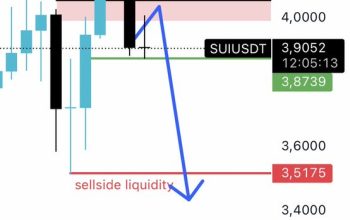Navigating the Cryptocurrency Market: A Deep Dive into Recent Trends and Insights
Introduction: The Volatile World of Cryptocurrency
The cryptocurrency market is renowned for its rapid price fluctuations, making it both an exciting and challenging space for investors. Recent data from Sentora, a leading DeFi analytics platform, suggests that Bitcoin (BTC) may be heading for a price correction. This analysis explores the factors contributing to the current market downturn, the potential implications for investors, and key strategies to navigate these turbulent waters.
—
Why Is Crypto Dropping Today?
1. Market Correction or Downtrend?
The recent dip in Bitcoin and Ethereum (ETH) prices has sparked debates among traders and analysts. Some argue that this is a natural market correction, while others believe it could signal the beginning of a downtrend. Historical data shows that Bitcoin has experienced 4 gains and 8 losses in August since 2013, indicating that the month has been historically volatile.
2. Key Factors Shaking the Market
Several factors are contributing to the current market instability:
– Strong U.S. Dollar: A stronger dollar often leads to selling pressure in cryptocurrencies, as investors seek safer assets.
– Whale Movement: Large investors (whales) moving significant amounts of BTC and ETH can trigger panic selling.
– Regulatory Uncertainty: Ongoing discussions around cryptocurrency regulations in major economies add to market volatility.
– Macroeconomic Conditions: Federal Reserve policies, inflation concerns, and global economic trends influence investor sentiment.
3. Trader Signals and Market Sentiment
Traders are closely monitoring on-chain data and technical indicators to gauge market direction. Some key signals include:
– Declining trading volumes suggesting weakening momentum.
– Increased exchange inflows, indicating potential sell-offs.
– Bearish technical patterns forming on Bitcoin’s price charts.
—
Bitcoin’s Recent Performance: A Closer Look
1. Bitcoin Dips Below $115,000
Bitcoin recently fell below the psychologically important $115,000 mark, raising concerns about further declines. This drop aligns with historical trends where Bitcoin has faced challenges in maintaining upward momentum during certain months.
2. Historical August Performance
Bitcoin’s performance in August has been mixed, with more losses than gains since 2013. This historical trend suggests that investors should exercise caution during this period.
3. Institutional and Retail Investor Behavior
– Institutional Investors: Large-scale investors like MicroStrategy (MSTR) continue to hold Bitcoin, but their trading activity can influence market sentiment.
– Retail Investors: Smaller traders often react to short-term price movements, leading to increased volatility.
—
Alternative Cryptocurrencies: What’s Moving the Market?
1. Pepe Coin ($PEPE) Analysis
Pepe Coin, a meme-inspired cryptocurrency, has gained attention due to its community-driven growth. Unlike utility-focused tokens, PEPE thrives on speculative trading and social media hype. Its price movements are highly influenced by trending memes and influencer endorsements.
2. Lista DAO (LISTA) Technical Analysis
Lista DAO has seen significant gains in recent months, with a 62.63% increase over 90 days. However, traders should watch for potential pullbacks as the market corrects.
3. Virtuals Protocol (VIRTUALS Coin) Overview
Virtuals Protocol integrates AI and Metaverse technologies, making it an interesting play in the evolving digital asset space. Its unique approach could attract long-term investors, but short-term volatility remains a risk.
—
Trading Strategies: Buy Now or Wait?
1. Short-Term Trading Opportunities
– Day Trading: Traders can capitalize on intraday volatility using technical analysis and stop-loss strategies.
– Swing Trading: Holding positions for a few days to weeks can help ride short-term trends.
2. Long-Term Investment Considerations
– Dollar-Cost Averaging (DCA): Investing fixed amounts regularly can mitigate the impact of volatility.
– Diversification: Spreading investments across multiple assets reduces risk.
3. Risk Management Tips
– Set Stop-Loss Orders: Automatically sell assets if they drop to a predetermined price.
– Avoid Emotional Trading: Stick to a well-defined strategy rather than reacting to FOMO (Fear of Missing Out) or panic.
—
Conclusion: Staying Informed in a Dynamic Market
The cryptocurrency market remains highly unpredictable, with Bitcoin and Ethereum facing selling pressure due to macroeconomic factors and trader behavior. While some see the current dip as a buying opportunity, others caution against further declines.
For investors, the key is to stay informed, diversify, and manage risk effectively. Whether you’re a short-term trader or a long-term holder, understanding market dynamics will help you navigate these volatile waters successfully.
—
Sources:
*(Note: Replace placeholder URLs with actual source links.)*




